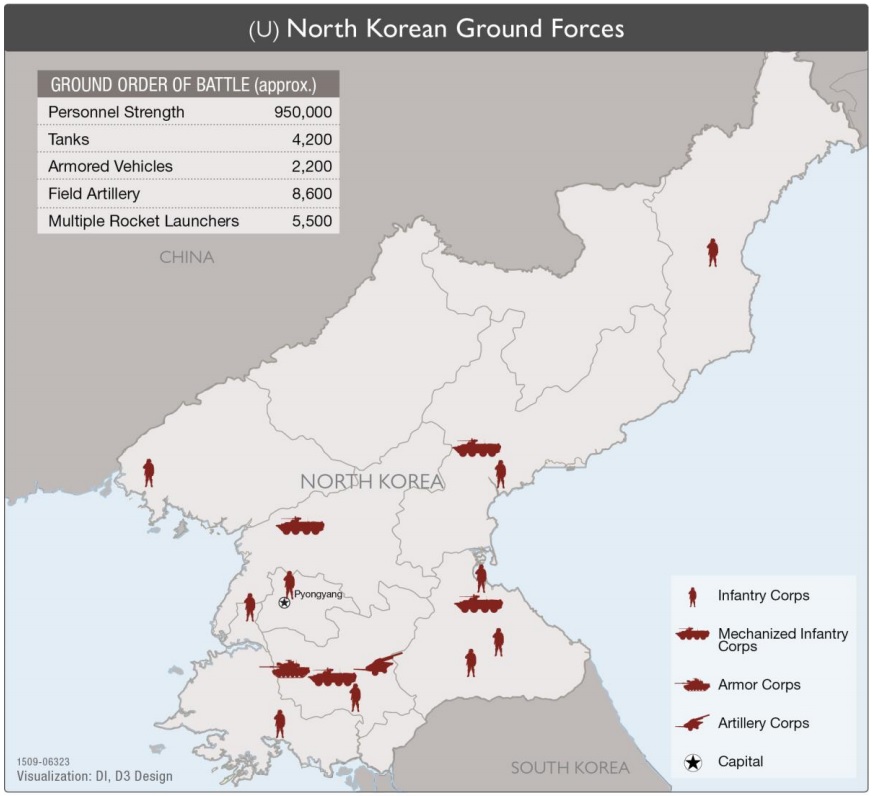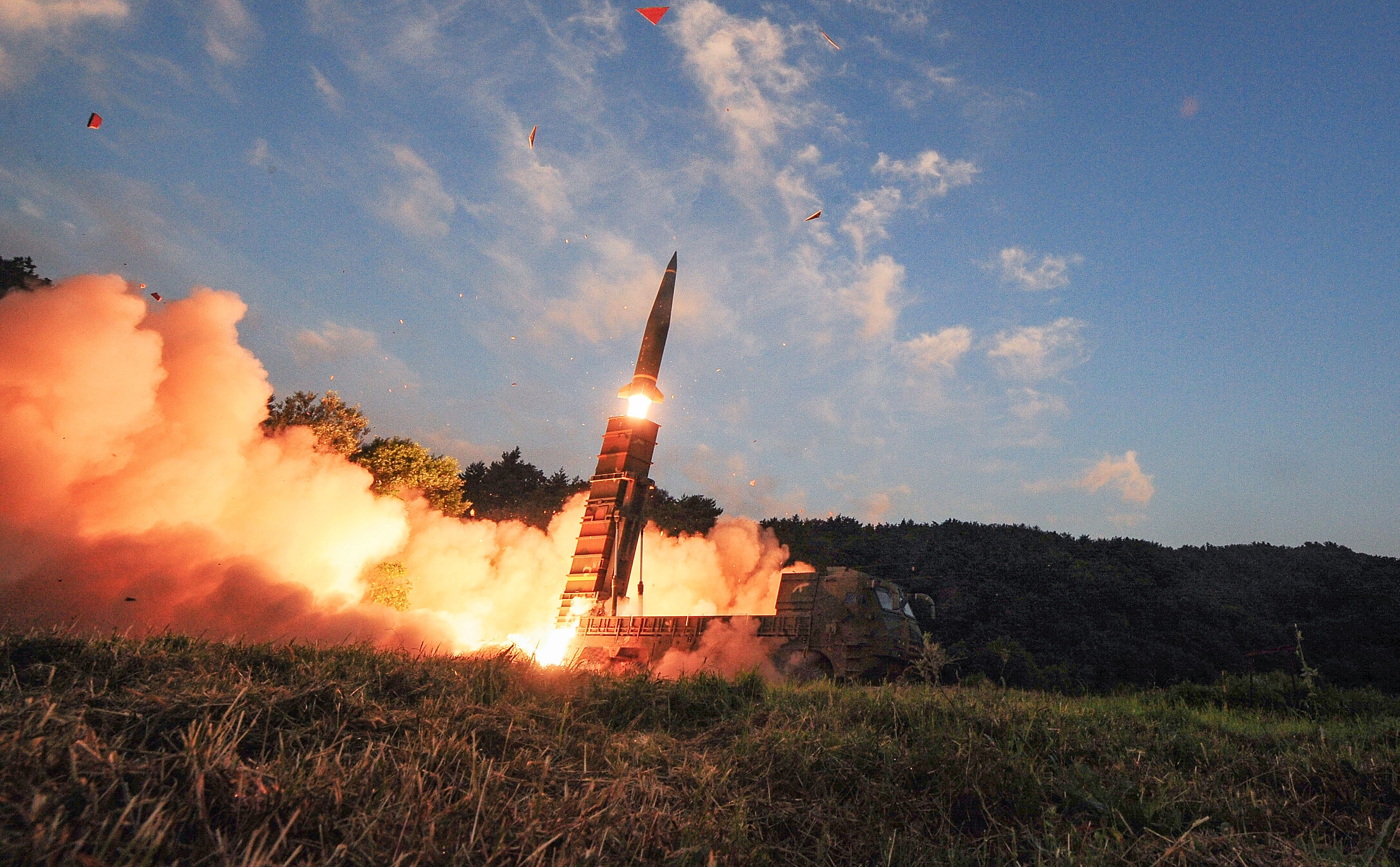North Korea has claimed that Donald Trump has declared war.
The US president had said North Korea’s leaders “won’t be around much longer” and referred to Kim Jong-Un as “Little Rocket Man”.
This followed Mr Trump’s speech to the UN last week in which he warned that America would “totally destroy” North Korea if the US and its allies were attacked.
The stand-off between the two countries has led to fears of nuclear war, but how likely really is this? And would North Korea stand a chance against the US?
How great is North Korea’s conventional military capability?
The exact details about North Korea’s armed forces are shrouded in secrecy, but estimates suggest it has the fourth largest military personnel in the world.
Data published by the World Bank estimates there are some 1,379,000 people on active duty in country’s military.
But a report to US Congress in 2015 said that between 6m and 7.2m reservists (around 25-30 per cent of the population) could be mobilised in a war. That would bring the total number of North Korean troops up to as many as 8.6m during wartime.
By contrast, there there are fewer than 196,000 UK service personnel. Even the US military is considerably smaller, with around 2.2m. Both of these figures include reservists.
However, although it has lots of troops, the equipment and weaponry used by North Korea’s military is ageing and has failed to keep up with regional neighbours. For instance, the US Congress report said it lacks defence from ballistic missiles and has not bought new fighter jets “in decades”.
But even taking these limitations into account, North Korea’s conventional military capability is still substantial. Ground forces alone have around 4,200 tanks and 5,500 multiple rocket launchers.

Overall, the regime “retains the capability to inflict serious damage on [South Korea], despite significant resource shortfalls and aging hardware,” the report says.
Chemical and biological weapons
As well as its conventional armed forces, North Korea is also believed to own chemical and biological weapons.
Its biological weapons programmes started in the 1960s and it is now able to produce a “limited quantities of toxins, as well as viral and bacterial biological warfare agents”, according to the Federation of American Scientists (FAS). If Kim Jong-Un decided to used them, he would probably target South Korea’s water and food supplies with something like anthrax or yellow fever.
However, the FAS points out that using biological weapons would be “as dangerous to its own forces as they are to South Korean or US forces, and the North’s limited medical services would make the agents more lethal. Therefore, using biological agents is not a likely option.”
But, of course, it is impossible to be sure. Indeed, the US Department of Defence has assessed that “North Korea may consider the use of biological weapons as an option”.
Meanwhile, the FAS described North Korea’s chemical weapons programme as “mature” with a “sizable stockpile” – it has had the capability to make them for many years. Experts say the country has been able to produce large quantities of nerve, blister, choking and blood chemical agents since 1989.
These provide North Korea with a significant defence. If used, the FAS says chemical weapons could “break through defensive lines or hinder a South Korean counterattack’s momentum”.
It adds: “In any attack on the South, Pyongyang could use chemical weapons to attack forces deployed near the [demilitarized zone], suppress allied airpower, and isolate the peninsula from strategic reinforcement.”
Nuclear missiles
This is probably the most secretive aspect of North Korea’s military capabilities. Experts are unclear on exactly how far it can fire nuclear missiles, or how powerful they are. One thing that most experts agree on, however, is that the technology appears to be improving.
For years, North Korea has had the ability to hit regional neighbours like Japan and South Korea. But Kim Jong-Un now says it is “capable of hitting any part of the world”. Based on the missile tests they’ve done so far, this seems like a bit of an overstatement – but it’s not that far off.

Judging by missile tests conducted this year, experts believe North Korea’s rockets now have a range of up to 10,000km, which would put everywhere from London to Delhi to San Fransico in the firing line.
The regime is also understood to be developing missiles with an even longer range, capable of reaching Cape Town, Mexico and New York.
The nuclear warheads are becoming more powerful, too. A test in 2006 caused an earthquake magnitude of 4.3; the latest measured 6.3. Analysts say the weapons are now more than five times as powerful as the one dropped on Hiroshima in 1945.
What are North Korea’s strategic options?
It’s impossible to be sure how North Korea will respond to the current stand-off with the USA, but experts have suggested a number of possibilities.
- Diplomatic and economic strategies
In the past, North Korea has used its nuclear capabilities as a bargaining chip. It could try to gain some economic benefits, or get food aid or energy assistance.
- Catalytic strategies
The regime could use the threat of nuclear war to persuade a third country (most likely China) to intervene and restore stability.
Dr Shane Smith, of the US National Defense University, says this strategy is believe to have been used by South Africa, Israel and Pakistan. However, he points out that this is a big gamble which relies on the other country to step in and settle the situation.
- Assurance of power strategies
These revolve around Kim Jong-Un asserting his country’s power and scaring others off the idea of attacking. Crucially, the aim would be to “ensure that enough weapons survive a first strike to threaten an adversary with unacceptable costs,” Smith says.
The more extreme of these type of strategies would see North Korea convincing other countries that it would be prepared to be the first to use nuclear weapons. This would allow it to exert power over other countries, rather than merely defending itself, giving it the potential to force a settlement or gain other advantages. However, this would be a risky tactic for Kim Jong-Un as it could push the US to attack.



